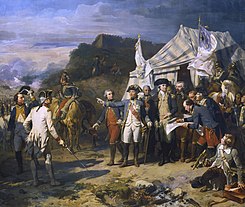
Expédition Particulière (English: Special Expedition) was the codename given by the Kingdom of France for the plan to sail French land forces to North America to support the colonists against Britain in the American Revolutionary War. Numbering 5,500 troops, the expedition arrived in America on 11 July 1780, led by the Comte de Rochambeau.
Another 2,500 men were intended to join the war effort, but could not escape the British blockade of Brest. After remaining inactive for almost a year, Rochambeau marched his troops south to rendezvous with George Washington's Continental Army for a planned attack on New York City. At Rochambeau's urging, Washington abandoned the planned attack and instead they moved into Virginia to join with the French fleet of Admiral François de Grasse to trap Lieutenant General Charles Cornwallis's British army at Yorktown; the subsequent Franco-American siege ended in British surrender in October 1781, which hastened negotiations towards a peace treaty ending the war.[1]
Background[edit]
France had been in contact with American Patriots as early as 1774, and by 1776 was sending large amounts of covert financial aid and military supplies to their cause. Following the loss of a British army during the Saratoga campaign of 1777, France signed a Treaty of Alliance in February 1778 recognising American independence. The subsequent Franco-American alliance legitimised the American cause while securing direct French aid in the war. Shortly thereafter, a French fleet under Charles Hector, comte d'Estaing sailed out to coordinate with American allies against the British, with the aim of helping bring a swift end to the war.
The initial attempts to seek victory were beset by problems. An operation against Newport miscarried in 1778; the following year, the Franco-American siege of Savannah ended in defeat. D'Estaing and his ships then sailed for home, with relations between the allies severely strained.
Expedition[edit]
On 2 May 1780,[2] Admiral Ternay d'Arsac departed Brest with a seven-ship and three-frigate squadron, escorting 36 transports carrying troops to support the Continental Army in the American Revolutionary War. The squadron comprised the 80-gun Duc de Bourgogne, under Ternay d'Arsac (admiral) and Médine (flag captain); the 74-gun Neptune, under Sochet Des Touches, and Conquérant, under La Grandière; and the 64-gun Provence under Lombard, Ardent under Bernard de Marigny, Jason under La Clocheterie and Éveillé under Le Gardeur de Tilly, and the frigates Surveillante under Villeneuve Cillart, Amazone under La Pérouse, and Bellone.[3] Amazone, which constituted the vanguard of the fleet, arrived at Boston on 11 June 1780.[4]
Organization[edit]
The Special Expedition contained four regiments of foot:[5]
- Régiment de Bourbonnais
- Régiment de Soissonnais
- Régiment de Saintonge
- Régiment de Royal–Deux–Ponts
One battalion of artillery:[5]
- Second Battalion, Régiment d'Auxonne
One combined-arms legion:[5]
Yorktown campaign[edit]

In July 1781, Rochambeau's army left Rhode Island and marched across Connecticut to join Washington's army on the Hudson River at Dobbs Ferry, New York. From there the combined forces marched overland to Virginia. During this time, Admiral de Grasse managed to defeat a British fleet sent from New York City to evacuate British General Charles Cornwallis at the Battle of the Chesapeake on September 5, trapping Cornwallis on the Yorktown peninsula. On September 22, Rochambeau and Washington combined forces with those of Marquis de Lafayette and began the siege of Yorktown. The siege ended with the surrender of Cornwallis on October 19, 1781.[7]
Departure to the West Indies[edit]
Rochambeau's force spent the winter in Virginia. The following year they moved north towards New England. Washington again tried to interest Rochambeau in an attack on New York City, Charleston or Canada but the Frenchman rejected the proposals. Orders instead arrived for his expedition to go to the West Indies and in late 1782 it sailed from Boston for Port-au-Prince. However, by then the Peace of Paris had been agreed and the planned 1783 campaign in the Caribbean never took place. In late April the French sailed for home, reaching Brest and Toulon in June and July 1783.[8]
Legacy[edit]
The Expedition has been described as the only substantial force of foreign allies ever to serve on United States soil for an extended period.[9]
Citations[edit]
- ^ McGee, Suzanne. "5 Ways the French Helped Win the American Revolution". HISTORY. Retrieved 2021-07-04.
- ^ Roche (2005), p. 159.
- ^ Lacour-Gayet (1910), p. 645.
- ^ Monaque (2000), p. 38.
- ^ a b c Selig, Robert (2007). March to Victory. U.S. Army Center of Military History. Special Publications CMH Pub 70-104-1, p. 3.
- ^ Conserved in the Galerie des Batailles, Château de Versailles, France. A copy is displayed at the Yorktown National Park Visitors' Center, Yorktown, Virginia.
- ^ Lengel, Edward (2005). General George Washington. New York: Random House Paperbacks. p.342.
- ^ Scott p.109-110
- ^ Scott p.3
Bibliography
- Salagnac, Georges Cerbelaud (1979). "Arsac de Ternay, Charles-Henri-Louis". In Halpenny, Francess G (ed.). Dictionary of Canadian Biography. Vol. IV (1771–1800) (online ed.). University of Toronto Press.
- Gardiner, Asa Bird (1905). The Order of the Cincinnati in France: ("lórdre de Cincinnatus") [...]. Rhode Island State Society of Cincinnati. p. 29.
- Lacour-Gayet, Georges (1910). La marine militaire de la France sous le règne de Louis XVI. Paris: Honoré Champion.
- Monaque, Rémi (2000). Les aventures de Louis-René de Latouche-Tréville, compagnon de La Fayette et commandant de l'Hermione (in French). Paris: SPM.
- Roche, Jean-Michel (2005). Dictionnaire des bâtiments de la flotte de guerre française de Colbert à nos jours. Vol. 1. Group Retozel-Maury Millau. p. 280. ISBN 978-2-9525917-0-6. OCLC 165892922.